Dynamic Characteristics of Asphalt Concrete as an Impervious Core in Embankment Dams under Varying Temperatures and Stress States
Abstract
:1. Introduction
2. Experimental Section
2.1. Mix Design and Specimen Preparation
2.2. Experimental Setup and Procedure
3. Experimental Results and Analysis
3.1. Maximum Dynamic Elastic Modulus
3.2. Damping Ratio
3.3. Deformation Characteristics
4. Computational Models for Maximum Dynamic Elastic Modulus and Damping Ratio
4.1. Temperature Influence Factor
4.2. Temperature Influence Factor
4.3. Calculation Model for Maximum Dynamic Elastic Modulus and Damping Ratio
4.3.1. Calculation Model for Maximum Dynamic Elastic Modulus
4.3.2. Calculation Model for Damping Ratio
5. Conclusions
Author Contributions
Funding
Institutional Review Board Statement
Informed Consent Statement
Data Availability Statement
Conflicts of Interest
References
- Long, A.; Sun, X.; Yu, Z.; Zhang, B.; Zhang, G.; Huang, P.; Wang, J. Experimental study and mechanism analysis on the basic mechanical properties of hydraulic basalt fiber asphalt concrete. Mater. Struct. 2022, 55, 161. [Google Scholar] [CrossRef]
- Hoeg, K.; Valstad, T.; Kjaernsli, B.; Ruud, A.M. Asphalt core embankment dams: Recent case studies and research. Int. J. Hydropower Dams 2007, 14, 112–119. [Google Scholar]
- Ning, Z.; Liu, Y.; Wang, W. Compressive Behavior of Hydraulic Asphalt Concrete under Different Temperatures and Strain Rates. J. Mater. Civ. Eng. 2021, 33, 04021013. [Google Scholar] [CrossRef]
- Hao, J. Important topics in development of asphalt concrete technology in China. J. Hydraul. Eng. 2008, 39, 1213–1219. (In Chinese) [Google Scholar]
- ICOLD. Bituminous Cores for fill Dam; Bulletin 84; ICOLD: Paris, France, 1992. [Google Scholar]
- Vahid, A.R. Asphalt concrete core dams, Listing in 2018 World Atlas & Industry Guide. Int. J. Hydropower Dams 2018. [Google Scholar] [CrossRef]
- ICOLD. Asphalt Cores for Embankment Dams; Bulletin 179; International Commission on Large Dams: Paris, France, 2018. [Google Scholar]
- Tang, R.; Yu, Z.; Liu, G.; Li, F.; Tang, W. Uniaxial Dynamic Compressive Behaviors of Hydraulic Asphalt Concrete under the Coupling Effect between Temperature and Strain Rate. Materials 2020, 13, 5348. [Google Scholar] [CrossRef]
- Du, X.; Wang, Y.; Lu, D. Non-linear uniaxial dynamic strength criterion for concrete. J. Hydraul. Eng. 2010, 41, 300–309. (In Chinese) [Google Scholar]
- Wang, W.; Hoeg, K. Simplified material model for analysis of asphalt core in embankment dams. Constr. Build. Mater. 2016, 124, 199–207. [Google Scholar] [CrossRef]
- Wang, W.; Hu, K.; Feng, S.; Li, G.; Hong, K. Shear behavior of hydraulic asphalt concrete at different temperatures and strain rates. Constr. Build. Mater. 2020, 230, 117022.1–117022.10. [Google Scholar] [CrossRef]
- Yu, L.; Jin, X.; Ding, Z. Experimental study on factors of dynamic properties of core wall asphalt concrete. J. Hydroelectr. Eng. 2013, 32, 194–197. (In Chinese) [Google Scholar]
- FeiziKhankandi, S.; Mirghasemi, A.A.; Ghalandarzadeh, A.; Hoeg, K. Cyclic triaxial tests on asphalt concrete as a water barrier for embankment dams. Soil Found. 2008, 48, 319–332. [Google Scholar] [CrossRef]
- Wang, W.; Hoeg, K. Cyclic Behavior of Asphalt Concrete Used as Impervious Core in Embankment Dams. J. Geotech. Geoenvironmental Eng. 2011, 137, 536–544. [Google Scholar] [CrossRef]
- Akhtarpour, A.; Khodaii, A. Experimental study of asphaltic concrete dynamic properties as an impervious core in embankment dams. Constr. Build. Mater. 2013, 41, 319–334. [Google Scholar] [CrossRef]
- Wang, J.; Tang, X.; He, X.; Zhang, L. A Multifactor Study on Dynamic Characteristics of Pouring Asphalt Concrete. Mater. Rep (In Chinese). 2018, 32, 2085–2090. [Google Scholar]
- DL/T5362-2018; Test Code for Hydraulic Asphalt Concrete. Professional Standard of the People’s Republic of China, General Office of the National Development and Reform Commission: Beijing, China, 2018.
- Weibiao, W.; Hoeg, K. The asphalt core embankment dam: A very competitive alternative. In Proceedings of the 1st International Symposium on Rockfill Dams, Chengdu, China, 18–20 October 2009. [Google Scholar]
- Vlad, A.; Jean, P.T.; Pierre, V. Design and Construction of Nemiscau-1 Dam, the First Asphalt Core Rockfill Dam in North America; Canada Dam Association: Markham, ON, Canada, 2010. [Google Scholar]
- Seo, J.W.; Park, D.W.; Le, T.H.M. Development of an asphalt concrete mixture for Asphalt Core Rockfill Dam. Constr. Build. Mater. 2017, 140, 301–309. [Google Scholar] [CrossRef]
- Chen, Y.; Wang, H.; Xu, S.; You, Z. High modulus asphalt concrete: A state-of-the-art review. Constr. Build. Mater. 2019, 237, 117653.1–117653.17. [Google Scholar] [CrossRef]
- Taherkhani, H.; Tajdini, M. Comparing the effects of nano-silica and hydrated lime on the properties of asphalt concrete. Constr. Build. Mater. 2019, 218, 308–315. [Google Scholar] [CrossRef]
- National Energy Administration of the People’s Republic of China, Design Specification of Asphalt Concrete Facings and Cores for Embankment Dams (DL/T 5411-2009); China Electric Power Press: Beijing, China, 2009.
- Yu, L.; Ding, Z.; Fu, S.; Jin, X. Study on the impact factors for the mix rate of hydraulic asphalt concrete based on orthogonal test. J. Water Resour. Water Eng. 2012, 23, 51–53. (In Chinese) [Google Scholar]
- Lun, J.; He, J.; Wang, H. The effects of oversized coarse aggregate rate on mechanical properties of asphalt concrete core wall. J. Water Resour. Water Eng. 2017, 28, 169–173. (In Chinese) [Google Scholar]
- Wang, W.; Hoeg, K. Method of Compaction has Significant Effects on Stress-Strain Behavior of Hydraulic Asphalt Concrete. J. Test. Eval. 2009, 37, 264–274. [Google Scholar]
- Ossa, A.; Gaxiola, A. Effect of water on the triaxial behavior under dynamic loading of asphalt concrete used in impervious barriers. Constr. Build. Mater. 2019, 208, 333–342. [Google Scholar] [CrossRef]
- Hardin, B.O.; Drnevich, V.P. Shear modulus and damping in soils: Measurement and parameter effects. J. Soil Mech. Found. Div. 1972, 98, 603–624. [Google Scholar] [CrossRef]
- Kong, X.; Liu, Y.; Yan, P. Temperature sensitivity of mechanical properties of cement asphalt mortars. J. Chin. Soc. 2010, 38, 553–558. (In Chinese) [Google Scholar]
- Ning, Z.; Liu, Y.; Wang, Q. Experimental study on the dynamic compressive behavior of asphalt concrete under different temperature. J. Vib. Shock 2021, 40, 243–250. (In Chinese) [Google Scholar]
- Chen, Y.; Jiang, T.; Huang, Z.; Fu, W. Effect of temperature on mechanical properties of asphalt concrete. Rock Soil Mech. 2010, 31, 2192–2196. (In Chinese) [Google Scholar]
- Shu, X.; Huang, B. Micromechanics-based dynamic modulus prediction of polymeric asphalt concrete mixtures. Compos. Part B Eng. 2008, 39, 704–713. [Google Scholar] [CrossRef]
- Liu, S.; Zhu, D.; Yao, Y.; Shi, C. Effects of strain rate and temperature on the flexural behavior of basalt and glass textile-reinforced concrete. J. Mater. Civ. Eng. 2018, 30, 04018172.1–04018172.13. [Google Scholar] [CrossRef]
- Scott, M. Applied Logistic Regression Analysis, 2nd ed.; SAGE: London, UK, 2001. [Google Scholar]
- Liu, Y.; Kong, X.; Zhang, Y.; Yan, P. Static and Dynamic Mechanical Properties of Cement-Asphalt Composites. J. Mater. Civ. Eng. 2013, 25, 1489–1497. [Google Scholar]
- Wang, L.; Shao, S.; Wang, S.; Zhao, C.; Shi, P.; Zhou, B. Compression curve characteristic of undisturbed loess. Rock Soil Mech. 2018, 40, 1076–1084+1139. (In Chinese) [Google Scholar]
- Li, F.; Yu, Z.; Hu, Y. Experimental Study on Dynamic Performance of Self-Compacting Lightweight Aggregate Concrete under Compression. Adv. Civ. Eng. 2019, 2019, 5384601. [Google Scholar] [CrossRef]
- Tan, F.; Huang, B.; Rao, X. Experimental study on dynamic properties of asphalt concrete core material. Chin. J. Geotech. Eng. 2013, 35, 383–387. (In Chinese) [Google Scholar]
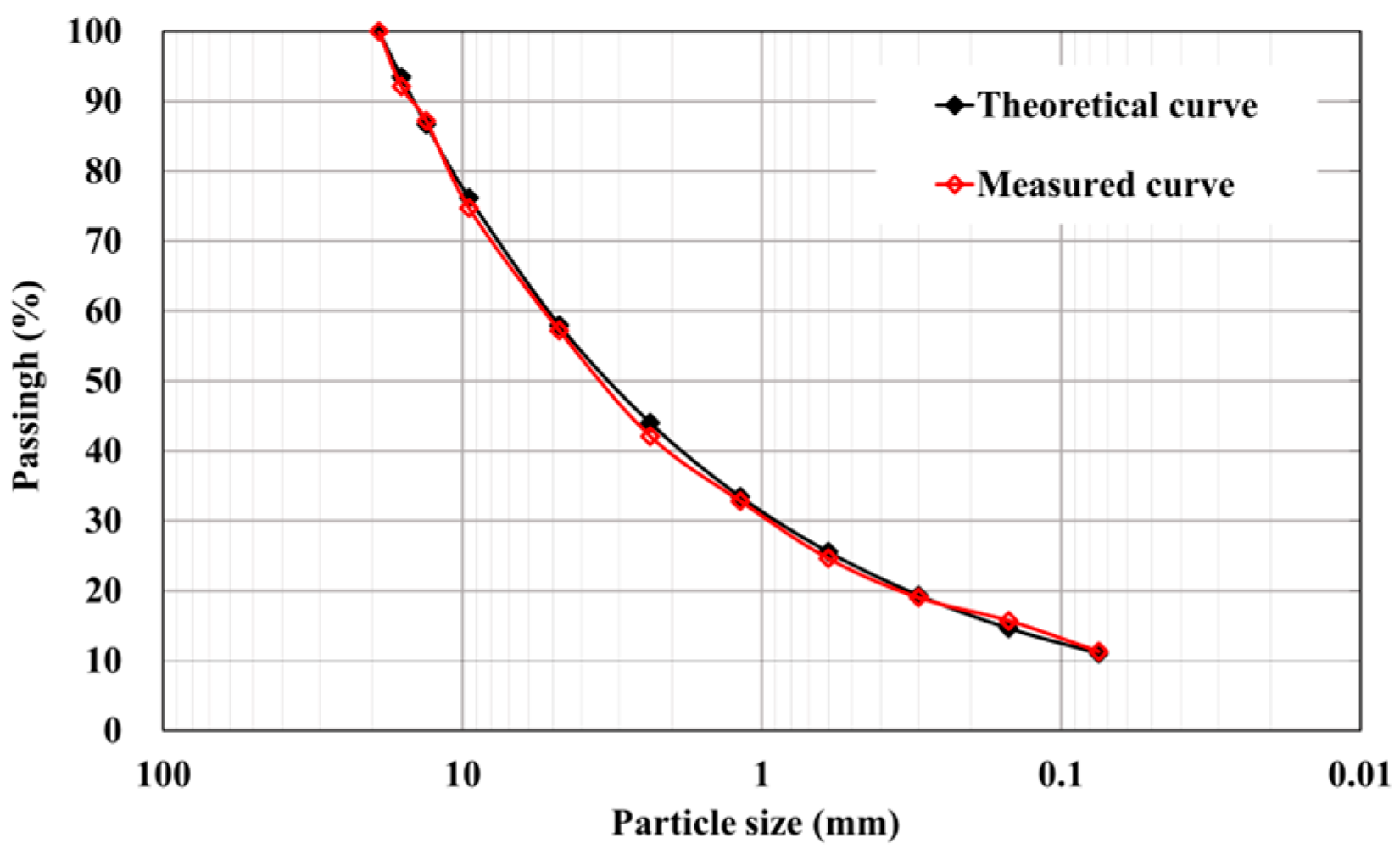
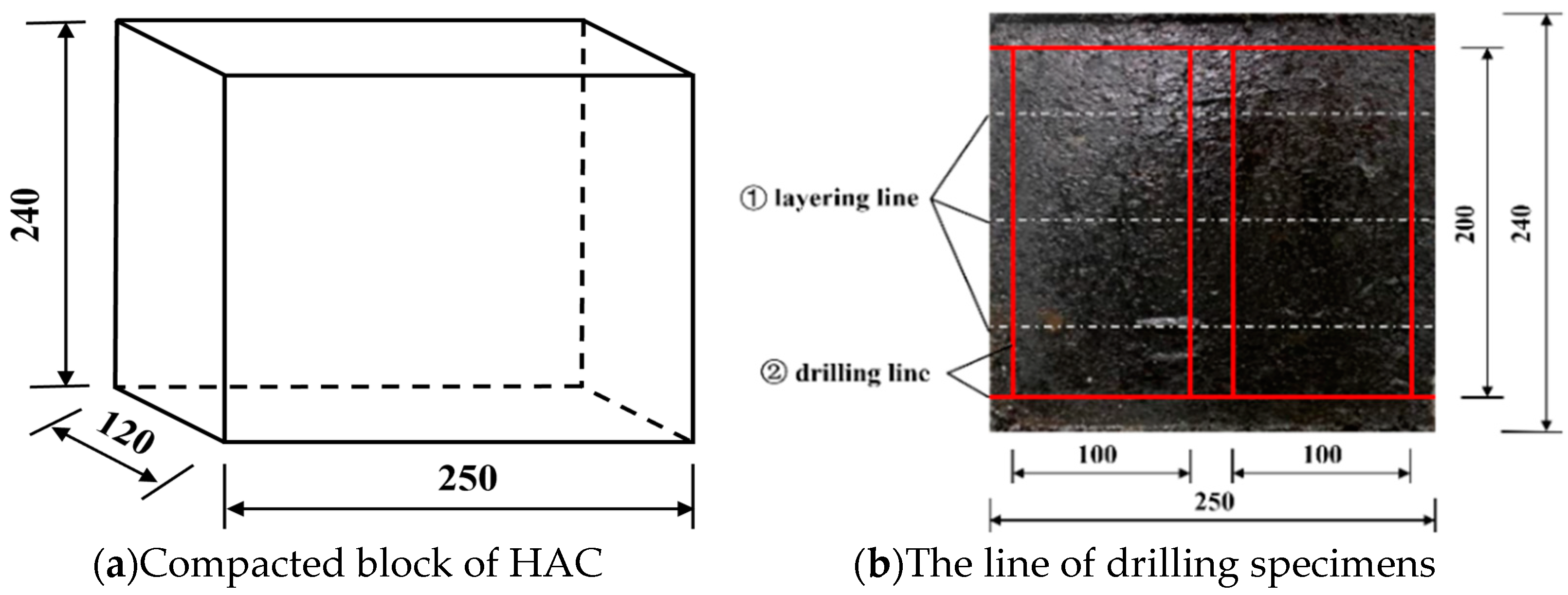

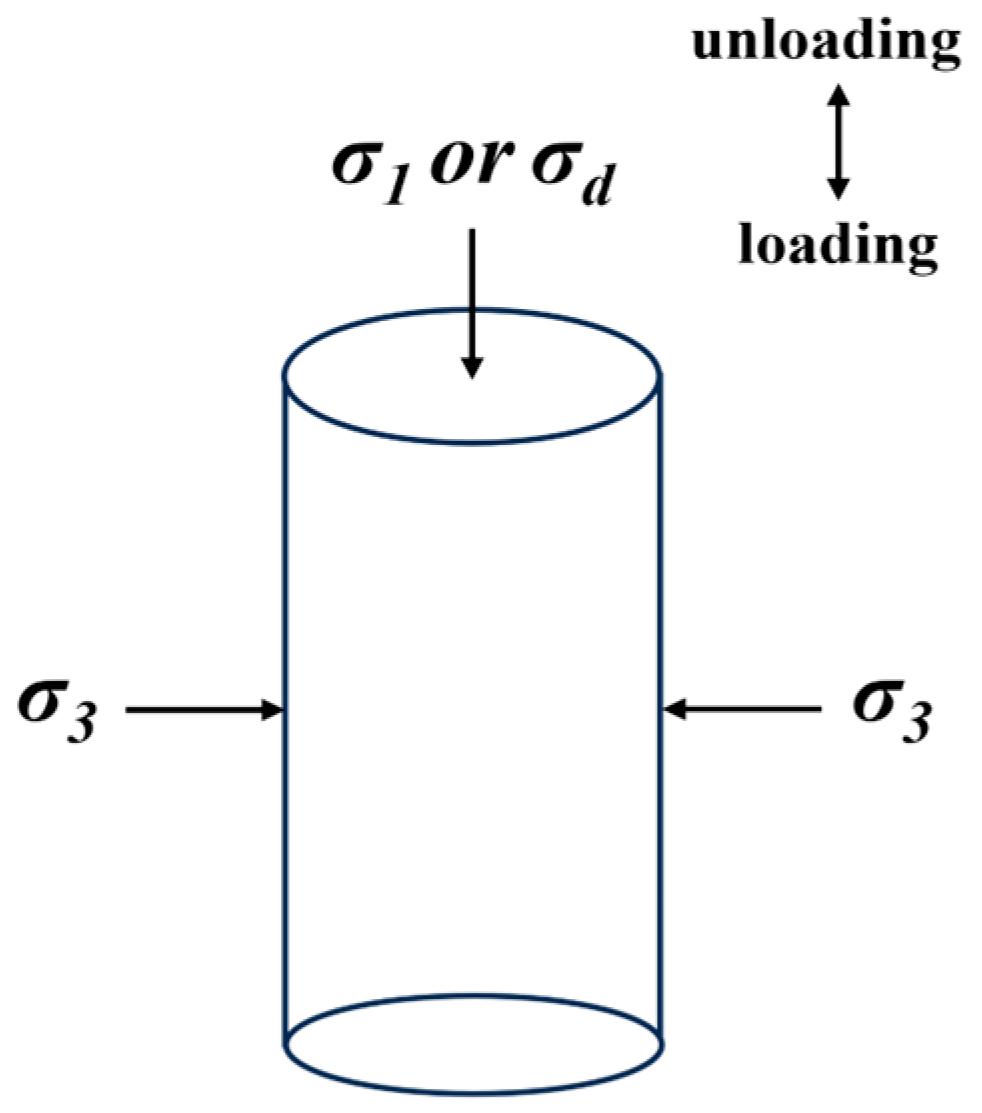
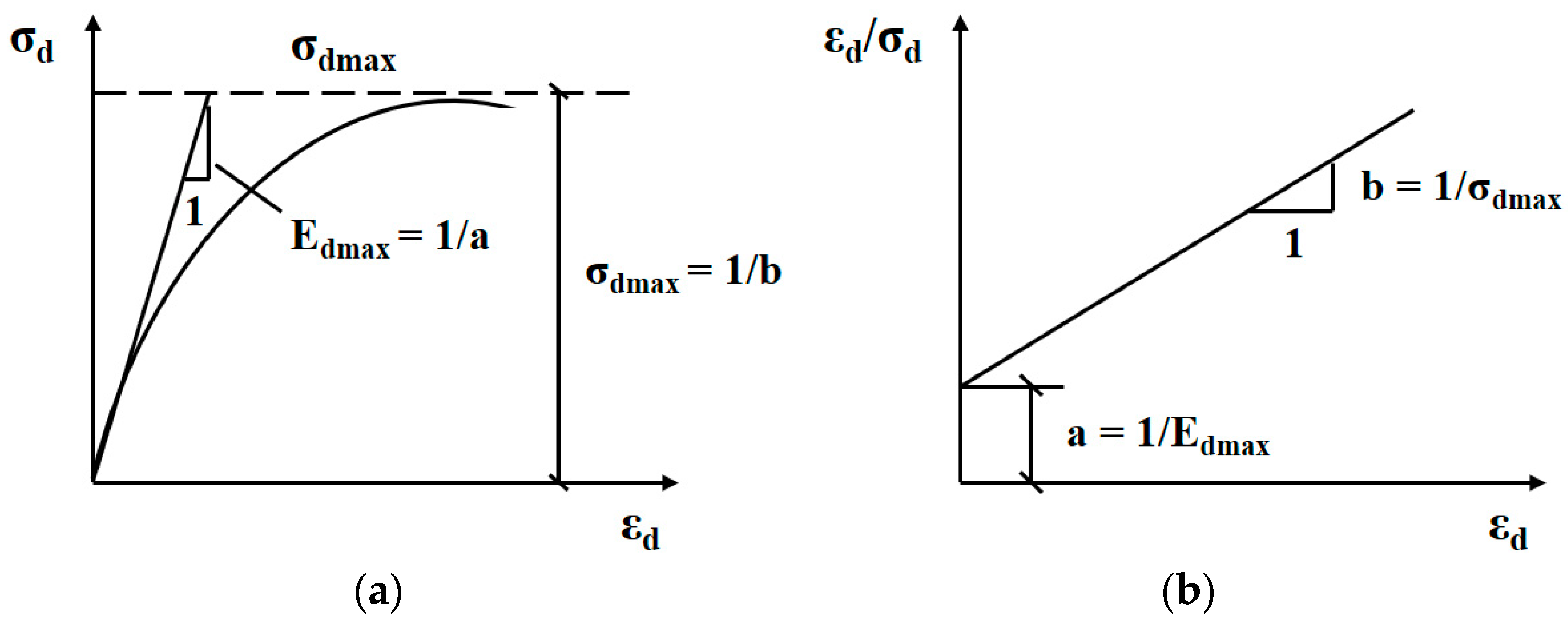
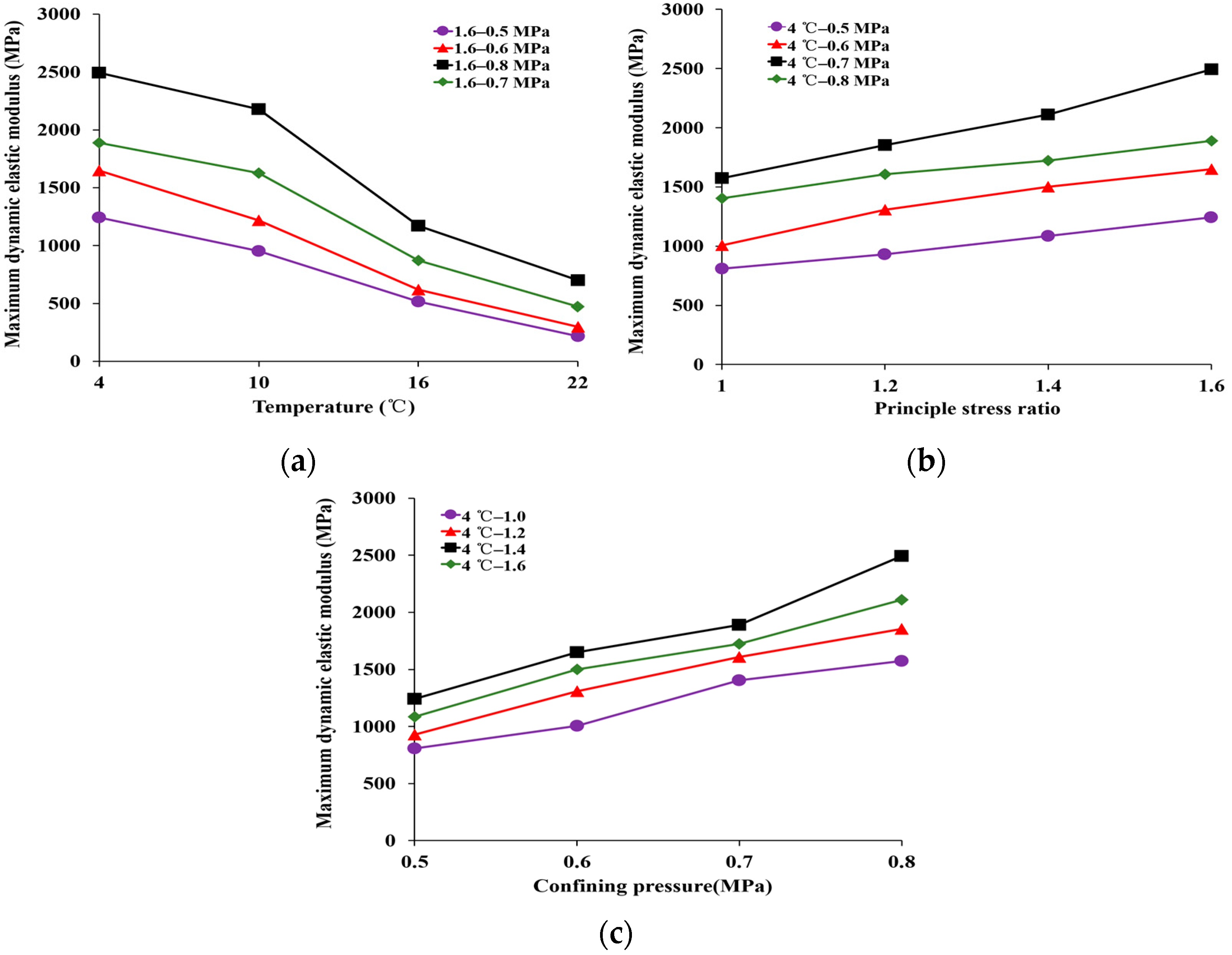
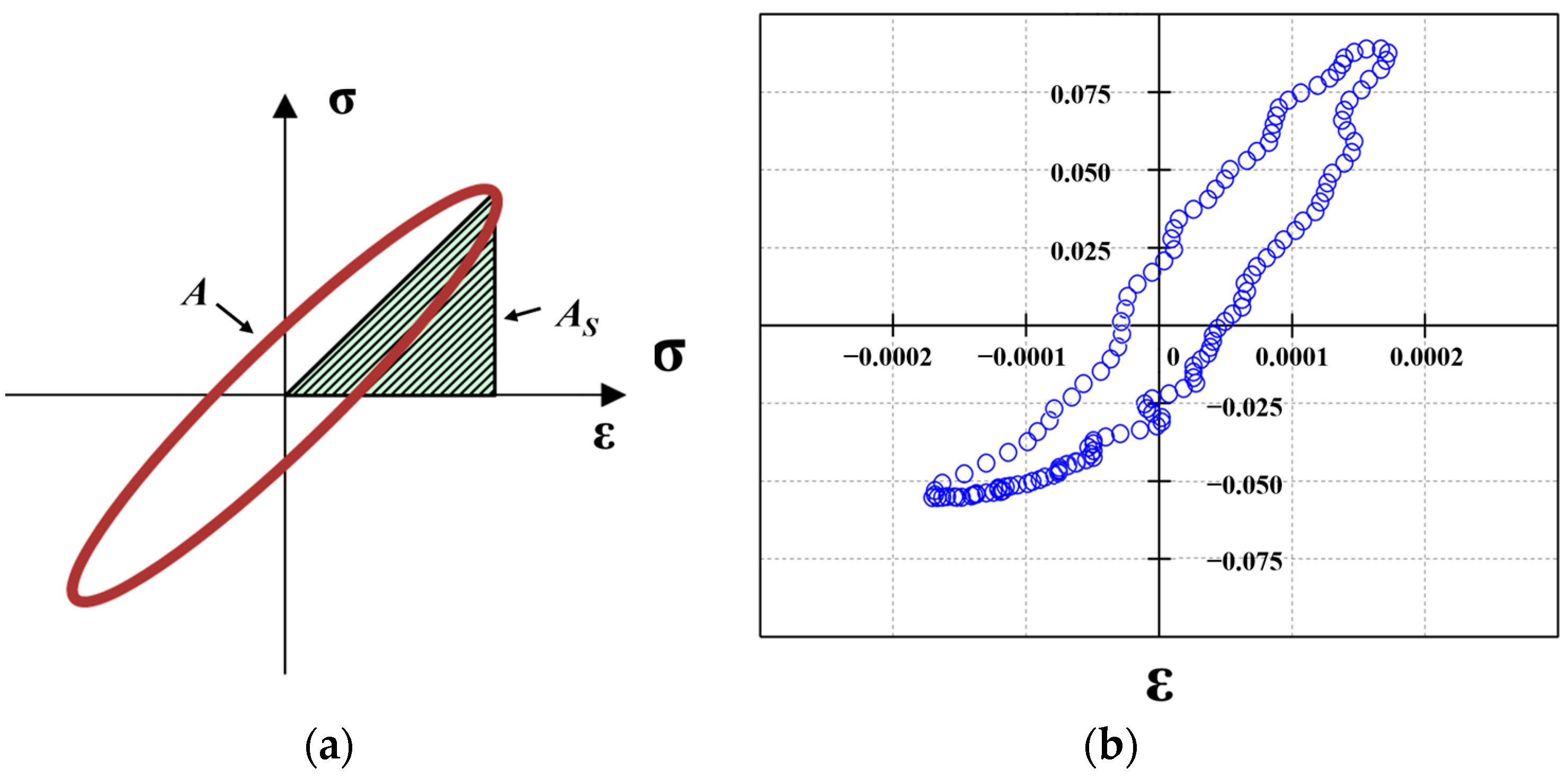
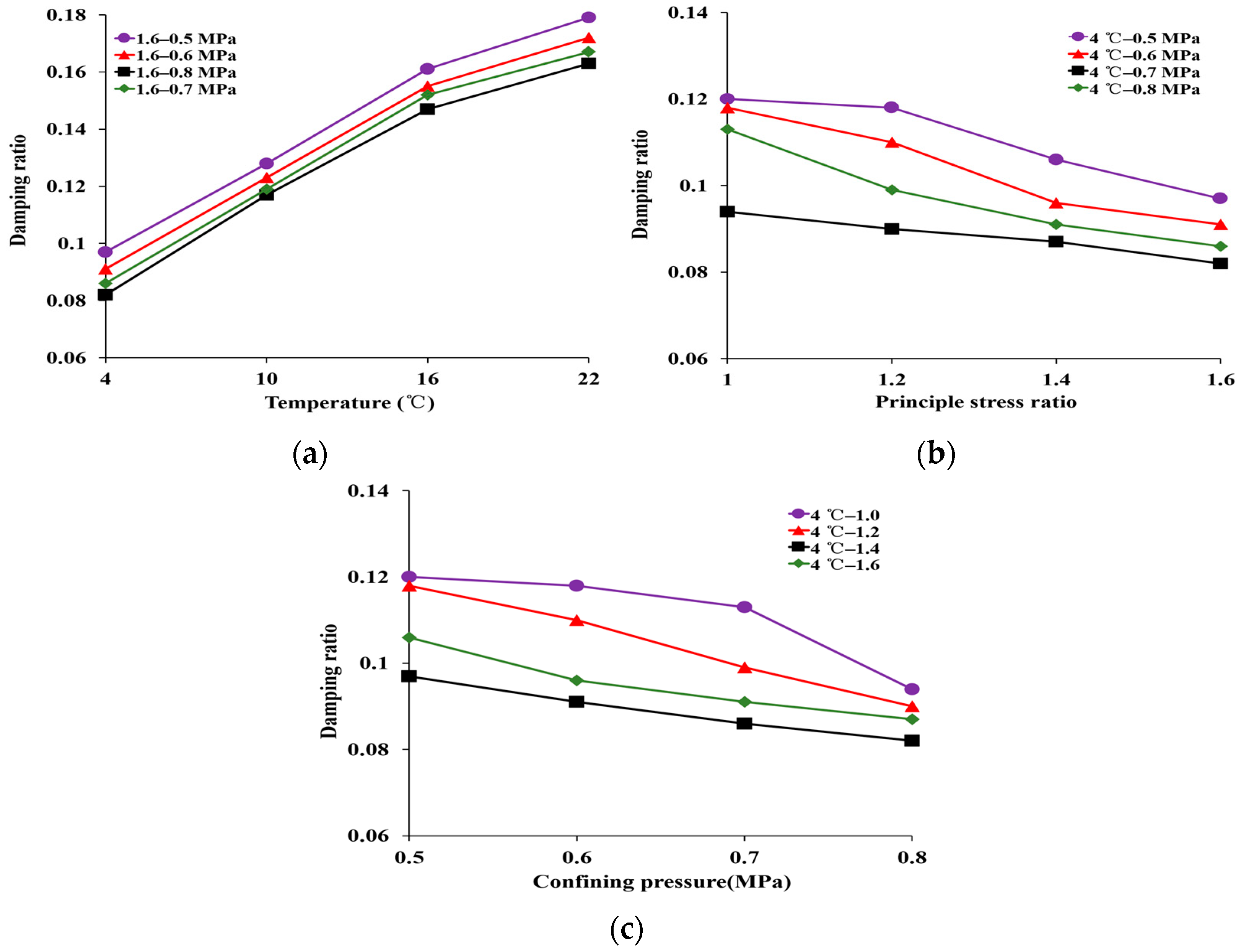
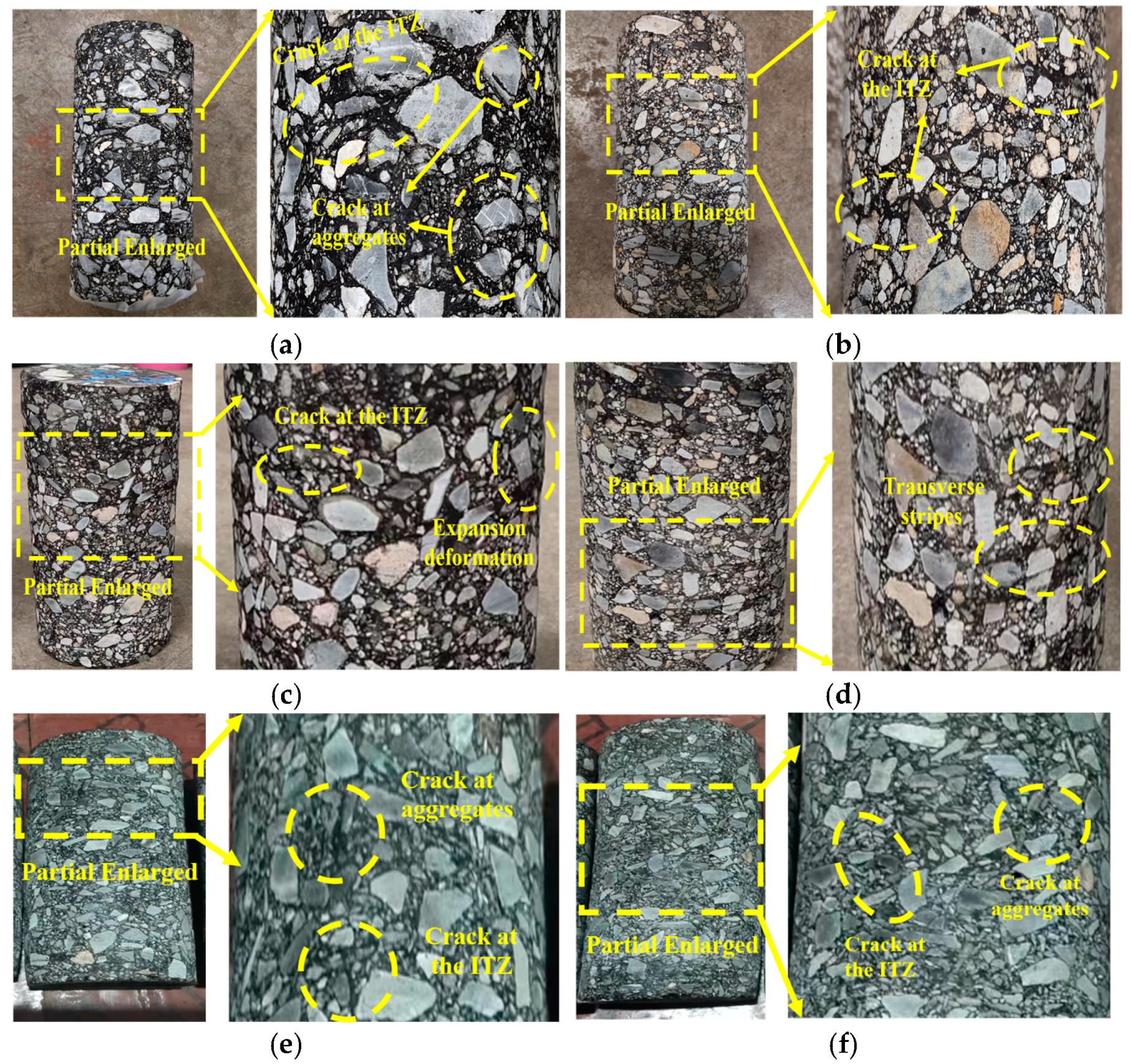


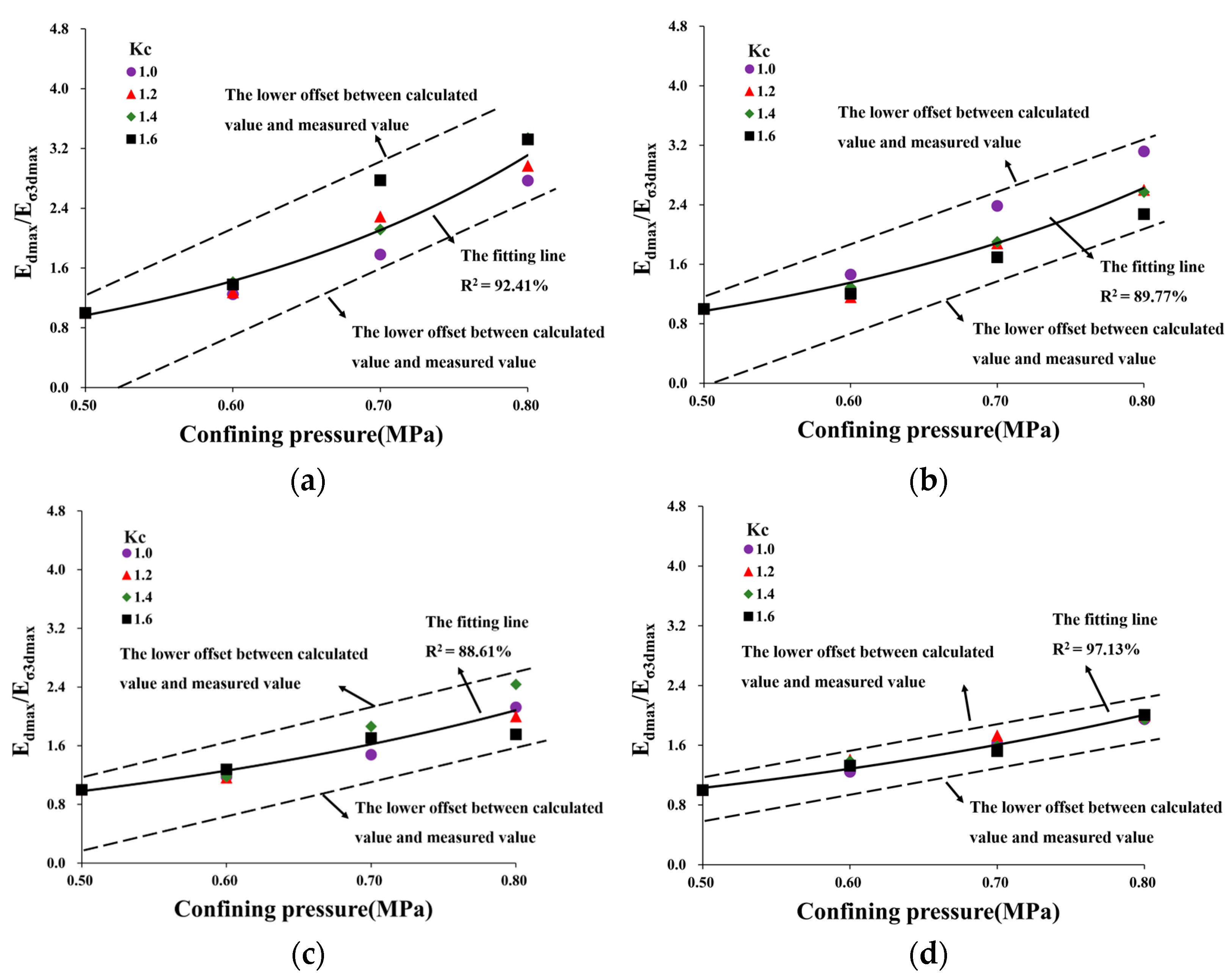
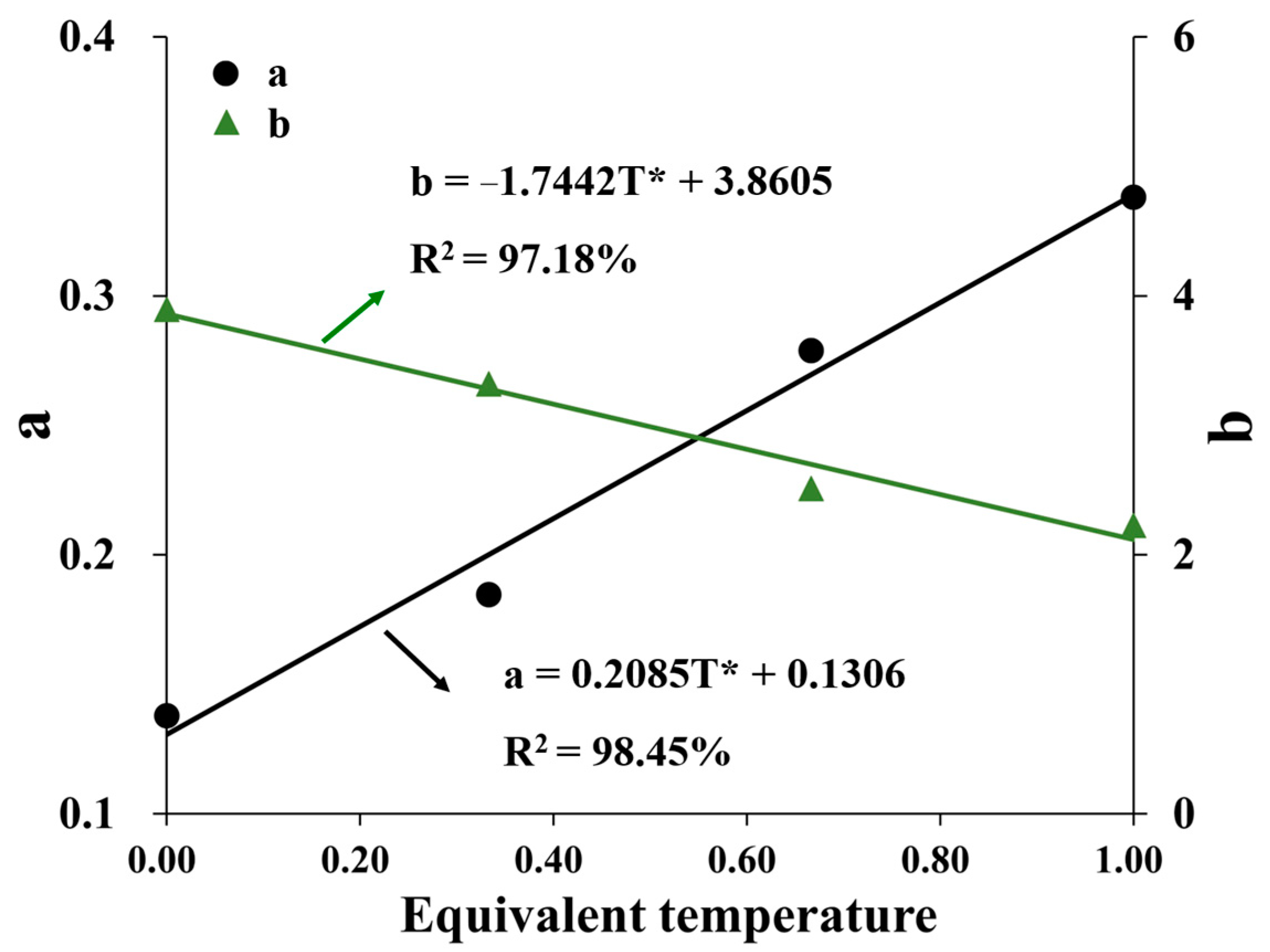
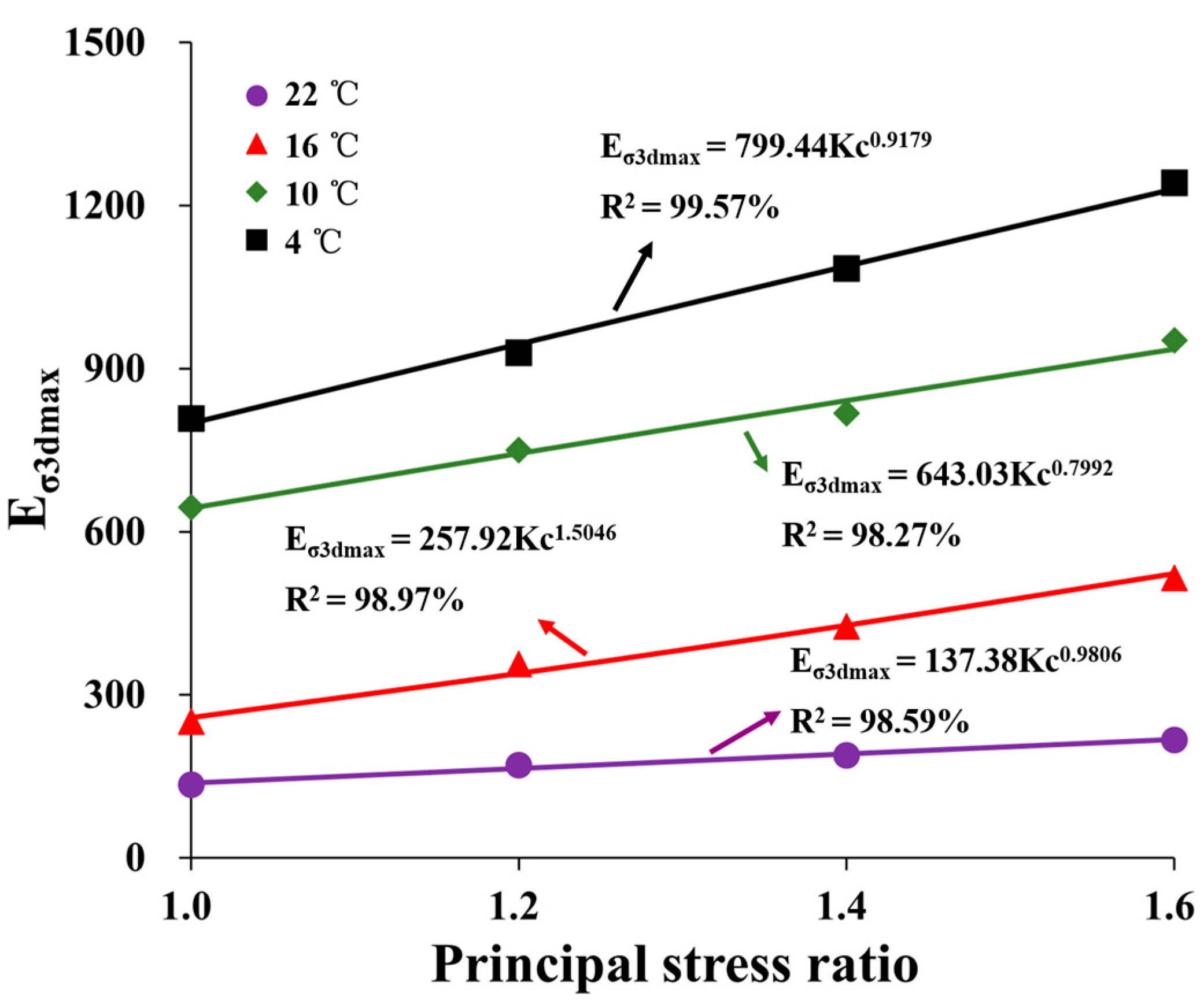

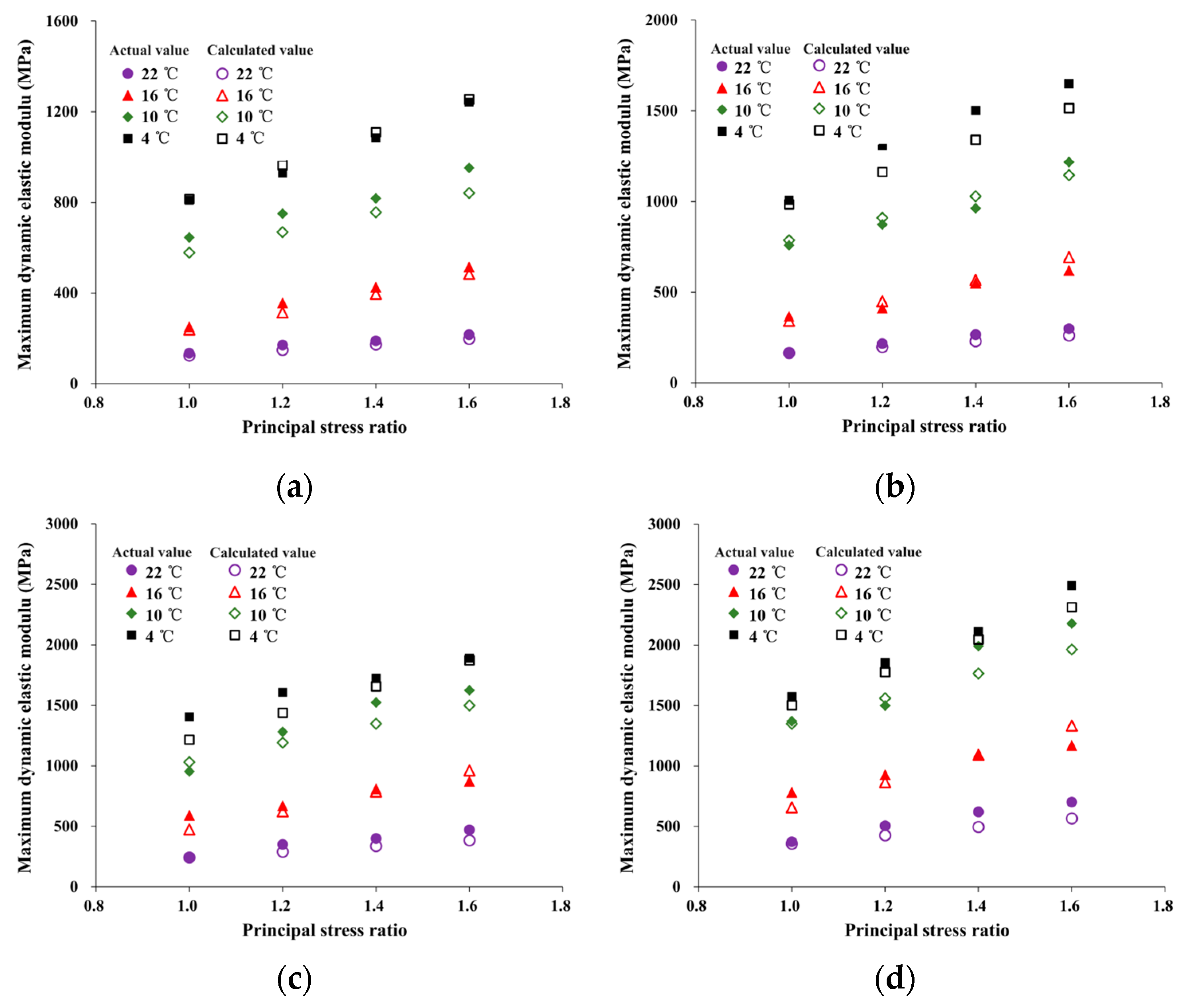
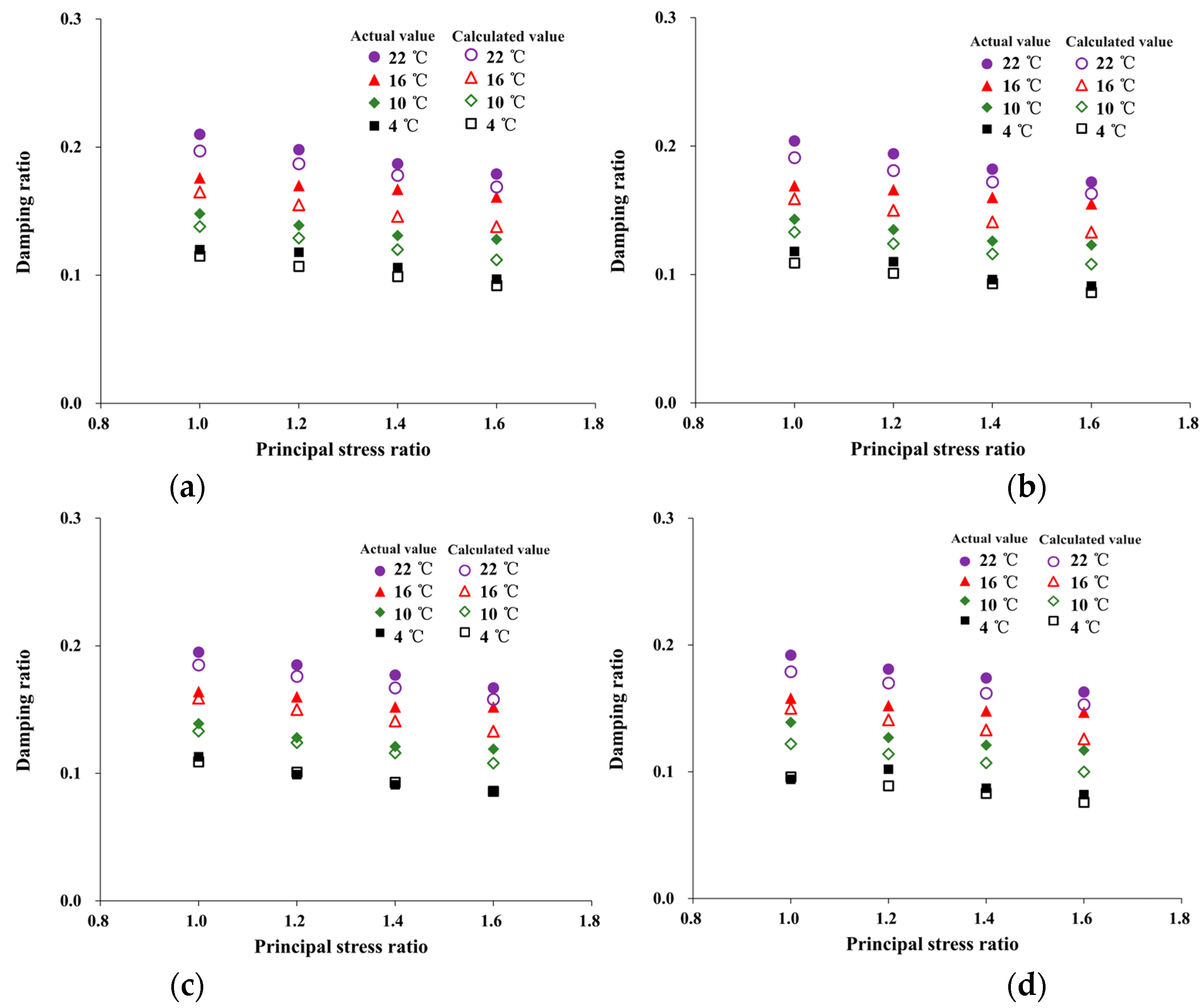
| Test Properties | Standard | Test Result | Test Method |
|---|---|---|---|
| Penetration (25 °C, 5 s, 100 g)/(0.1 mm) | 60–80 | 72.8 | DL-T5362-2018 [17] |
| Softening point/(°C) | ≥45 | 48.2 | |
| Ductility (5 cm/min, 15 °C)/(cm) | ≥150 | 157 | |
| Density (25 °C)/(g/cm3) | - | 0.989 | |
| TFOT | |||
| Loss by mass (%) | ±0.8 | 0.028 | |
| Residual penetration (%) | ≥61 | 77 | |
| Residual ductility (5 cm/min, 15 °C)/(cm) | ≥80 | 91 | |
| Factors | The Level of Factor |
|---|---|
| Bitumen aggregate ratio | 6.5%, 7.5%, 8.5% |
| Filler content | 11%, 13%, 15% |
| Graded index | 0.36, 0.39, 0.42 |
| Particle Size (mm) | Coarse Aggregate | Fine Aggregate | Fine | ||||||||
|---|---|---|---|---|---|---|---|---|---|---|---|
| 19.00–16.00 | 16.00–13.20 | 13.20–9.50 | 9.50–4.75 | 4.75–2.36 | 2.36–1.18 | 1.18–0.60 | 0.60–0.30 | 0.30–0.15 | 0.15–0.075 | <0.075 | |
| Percent (%) | 6.52 | 6.80 | 10.51 | 18.19 | 13.99 | 10.57 | 7.89 | 6.19 | 4.73 | 3.61 | 11.00 |
| σ3/MPa | Kc | k | a | b | R2 |
|---|---|---|---|---|---|
| 0.5 | 1.0 | 2.211 | 6.978 | 4.914 | 0.999 |
| 1.2 | 2.346 | 3.411 | 4.190 | 0.999 | |
| 1.4 | 2.484 | 2.808 | 3.967 | 0.998 | |
| 1.6 | 2.601 | 2.302 | 3.962 | 0.998 | |
| 0.6 | 1.0 | 2.425 | 3.536 | 4.113 | 0.999 |
| 1.2 | 3.048 | 2.910 | 2.743 | 0.999 | |
| 1.4 | 3.135 | 2.098 | 2.504 | 0.993 | |
| 1.6 | 3.094 | 1.816 | 2.843 | 0.999 | |
| 0.7 | 1.0 | 2.599 | 1.885 | 3.992 | 0.990 |
| 1.2 | 3.223 | 1.392 | 2.209 | 0.998 | |
| 1.4 | 3.029 | 1.205 | 3.087 | 0.998 | |
| 1.6 | 3.615 | 1.047 | 1.582 | 0.985 | |
| 0.8 | 1.0 | 2.888 | 1.199 | 3.305 | 0.999 |
| 1.2 | 3.304 | 0.922 | 1.961 | 0.999 | |
| 1.4 | 3.291 | 0.805 | 2.529 | 0.989 | |
| 1.6 | 3.953 | 1.041 | 1.596 | 0.978 |
| σ3/MPa | Kc | Bλ | R2 |
|---|---|---|---|
| 0.5 | 1.0 | 3.344 | 0.998 |
| 1.2 | 3.439 | 0.998 | |
| 1.4 | 3.560 | 0.999 | |
| 1.6 | 3.652 | 0.999 | |
| 0.6 | 1.0 | 3.410 | 0.997 |
| 1.2 | 3.512 | 0.998 | |
| 1.4 | 3.657 | 0.999 | |
| 1.6 | 3.735 | 0.999 | |
| 0.7 | 1.0 | 3.488 | 0.998 |
| 1.2 | 3.656 | 0.998 | |
| 1.4 | 3.750 | 0.999 | |
| 1.6 | 3.846 | 0.999 | |
| 0.8 | 1.0 | 3.632 | 0.998 |
| 1.2 | 3.656 | 0.998 | |
| 1.4 | 3.750 | 0.999 | |
| 1.6 | 3.846 | 0.999 |
| Various Factors and Levels | Maximum Dynamic Elastic Modulus | ||||
|---|---|---|---|---|---|
| T (°C) | Kc - | σ3 (MPa) | Provided Value /MPa | Calculated Value /MPa | Relative Error /% |
| 9 | 1.5 | 0.6 | 1200 | 996.35 | 16.97 |
| 0.8 | 1700 | 1957.26 | 15.13 | ||
| 20 | 1.2 | 0.5 | 730 | 666.06 | 8.76 |
| 1.5 | 0.5 | 730 | 771.75 | 5.71 | |
| Various Factors and Levels | Damping Ratio | ||||
|---|---|---|---|---|---|
| T (°C) | Kc - | σ3 (MPa) | Provided Value | Calculated Value | Relative Error /% |
| 5.4 | 1.2 | 0.6 | 0.054 | 0.055 | 2.82 |
| 1.5 | 0.049 | 0.051 | 4.58 | ||
| 15.4 | 1.2 | 0.6 | 0.073 | 0.074 | 1.37 |
| 1.5 | 0.060 | 0.057 | 3.60 | ||
Disclaimer/Publisher’s Note: The statements, opinions and data contained in all publications are solely those of the individual author(s) and contributor(s) and not of MDPI and/or the editor(s). MDPI and/or the editor(s) disclaim responsibility for any injury to people or property resulting from any ideas, methods, instructions or products referred to in the content. |
© 2023 by the authors. Licensee MDPI, Basel, Switzerland. This article is an open access article distributed under the terms and conditions of the Creative Commons Attribution (CC BY) license (https://creativecommons.org/licenses/by/4.0/).
Share and Cite
Han, X.; Hu, Z.; Yu, L.; Pang, Y.; She, H.; Zhang, L.; Wang, X.; Qi, C. Dynamic Characteristics of Asphalt Concrete as an Impervious Core in Embankment Dams under Varying Temperatures and Stress States. Materials 2023, 16, 6529. https://doi.org/10.3390/ma16196529
Han X, Hu Z, Yu L, Pang Y, She H, Zhang L, Wang X, Qi C. Dynamic Characteristics of Asphalt Concrete as an Impervious Core in Embankment Dams under Varying Temperatures and Stress States. Materials. 2023; 16(19):6529. https://doi.org/10.3390/ma16196529
Chicago/Turabian StyleHan, Xiaoning, Zaiqiang Hu, Liangshu Yu, Yuan Pang, Haicheng She, Longfei Zhang, Xiaoliang Wang, and Changjun Qi. 2023. "Dynamic Characteristics of Asphalt Concrete as an Impervious Core in Embankment Dams under Varying Temperatures and Stress States" Materials 16, no. 19: 6529. https://doi.org/10.3390/ma16196529
APA StyleHan, X., Hu, Z., Yu, L., Pang, Y., She, H., Zhang, L., Wang, X., & Qi, C. (2023). Dynamic Characteristics of Asphalt Concrete as an Impervious Core in Embankment Dams under Varying Temperatures and Stress States. Materials, 16(19), 6529. https://doi.org/10.3390/ma16196529





